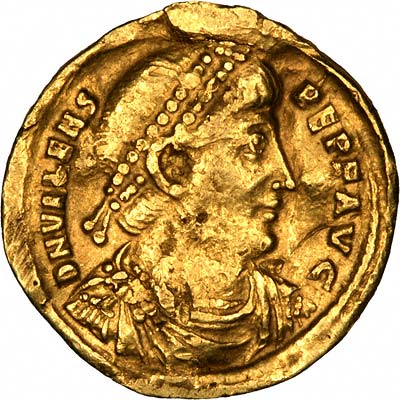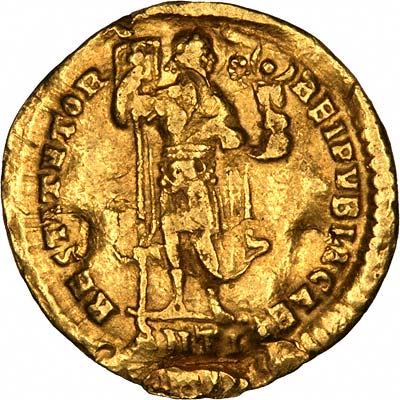| The Very Highest Quality Roman Portraits... |
| Portrait Gallery of Roman Emperors |

| |
|
| |

| |
|
| |
Taking the Purple
In 364, the Emperor Jovian's brief reign came to an end when he succumbed to carbon monoxide poisoning in his quarters whilst travelling back to Constantinople. The troops present hailed Valentinian as Emperor. Valentinian decided to appoint his younger brother as his co-emperor, with responsibility for the East, whilst he took control of the West.
It was considered that the East would be easier for Valens to govern than the West, as its military needs were not considered as desperate. Valentinian rightly considered himself the superior general to his younger brother, and soon afterwards, they parted ways to govern their respective portions of the Empire.
The Revolt of Procupius
As Valens journeyed towards the Eastern capital, Constantinople, he received news that Procupius, a member of the Constantinian dynasty, had revolted and seized the city. Valens dispatched two legions to put down the usurper, but instead they defected to Procupius' cause. Procupius enjoyed widespread support due to his connections with the former ruling dynasty and amongst sections of the population who had reason to fear Valens' zealous persecution of those who did not share his Arian Christian faith.
Valens' position seemed precarious, and to make matters worse, his brother, who had his own problems to deal with in the west, refused to dispatch any substantial military aid to help him crush the usurper. The allegiance of the supporters of both men was fickle to say the least, and much of the struggle was in trying to maintain their allegiance or gain that of the others. However, in 366, the two armies finally met at Thyatira, and the result was a victory for Valens, following which, the remnants of Procupius' army defected to Valens and handed Procupius over for execution. Valens subsequently despatched the usurper's severed head in triumph to his elder brother in the West.
The War Against the Goths
Having secured his position internally in the East, Valens faced a new threat. The Goths present in the Danube region, who had supported Procupius' revolt, threatened to launch a revolt of their own in 367. Valens diverted his troops from a planned campaign against the Persians in order to pacify them. Valen's campaign was delayed by flooding, which made crossing the river Danube impossible. However, two years later, Valens was able to cross into Gothic territory and defeat two Gothic armies, bringing them to terms. Valens then turned his attention back towards the East and resumed his plans for a campaign against the Persians. Valens spent the next few years in Armenia, trying to restore Rome's puppet king to the throne. In 375, Valentinian died, and his sons Gratian and Valentinian II took control of the West (nominally in the case of the latter, as Valentinian II was only an infant). That same year, the Goths returned with substantial reinforcements, with refugees having flooded across the borders of the Roman Empire seeking asylum from the Huns, who were ravaging the Goth's land in the East. The arrival of over a million Goths in Roman territory presented a substantial threat to the security of the Empire, but also an opportunity. The Goths, if settled properly on vacant and unused land, would provide a valuable source of tax revenue and recruits for Valens, who desperately needed funds and troops if he was to successfully wage war against the Persians. Unfortunately, the attempt to control the massive influx of Goths was botched. The Roman forces present in the area were insufficient, and the Roman officials sent to manage the situation were corrupt and/or incompetent, and only managed to offend, abuse and insult the Gothic chieftains trying to negotiate the terms of the resettlement. In 377, the Goths revolted, defeated local Roman forces, and began to ravage Thrace. Valens was forced to shelve his plans and return to deal with the rebellion.
The Battle of Hadrianople
In 378, as Valens was busy readying his army for the campaign against the Goths (led mostly by Fritigen, his one-time ally and Arian co-religionist), his nephew Gratian had made a name for himself by utterly destroying the Letientese at the battle of Arengtovaria. This decisive battle sealed Gratian's reputation as a military commander, and Valen's jealousy of his nephew's achievement spurred him to make a rash decision that would end up costing his life.
Instead of waiting for Gratian to bring his victorious and experienced army to join him so that they could launch a coordinated attack against the Goths together, Valens made the fateful decision to move against the Goths alone. To be fair to Valens, his scouts had grossly underestimated the strength of the Gothic army, and Valens believed that he outnumbered the Goths, when in fact they outnumbered him. When Valens launched an attack on the Goth's defensive Laager (a wagon train drawn into a circle) a large Gothic cavalry force arrived on the scene, drove off the Roman cavalry force and charged straight into the flanks of the assaulting Roman infantry. The result was a catastrophic loss for the Romans. Two thirds of Valens' army was destroyed, and Valens himself was killed. He was succeeded by the general Theodosius, who enjoyed the support of Gratian.
Legacy
The destruction of Valens' army at Hadrianople was held by some to be the beginning of the end of the Roman Empire in the West. This is perhaps overstated, as Valens was the Emperor of the East, which lasted until 1453, and not the West. The defeat at Hadrianople, and the subsequent death of Valens, did however, lead to the decline of Arianism and the rise of the Nicene Creed as the main Christian theological tradition within the Empire, from which the Roman Catholic and Eastern Orthodox churches descend.
Numismatically, Valens' coins are typical of the late Roman Empire. The solidus illustrated is of the type that would have been used to the pay the soldiers of Valens' army, and may well have been handled by one of the soldiers who fought and maybe died at that fateful battle at Hadrianople in 378.
Featured Coin
A Solidus of Valens, crediting Valens as the 'Restorer of the Republic'
Roman Emperors Portrait Gallery
You may wish to visit our portrait gallery of Roman emperors. Although it is not complete, we add new and better coins when we can. We are always keen to buy superior quality Roman coins to upgrade our photo gallery.
If you want to find the value of a coin you own, please take a look at our page I've Found An Old Coin, What's It Worth?
| ...at the Lowest Possible Price |
|
32 - 36 Harrowside, Blackpool, Lancashire, FY4 1RJ, England. Telephone (44) - (0) 1253 - 343081 ; Fax 408058; E-mail: info@chards.co.uk The URL for our main page is: https://24carat.co.uk Chard(1964) Ltd |